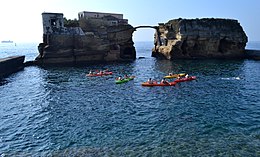
The province of Grosseto is a province in the Tuscany region of Italy. Its capital is the city of Grosseto. As of 2013 the province had a total population of 225,098 people.
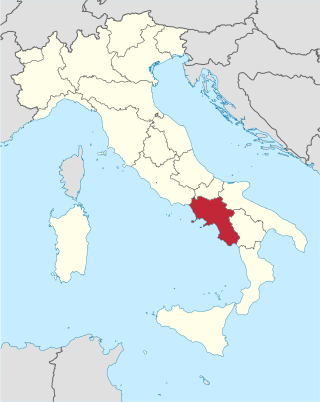
Campania is an administrative region of Italy located in Southern Italy; most of it is in the south-western portion of the Italian Peninsula, but it also includes the small Phlegraean Islands and the island of Capri. The capital of the Campania region is Naples. As of 2018, the region had a population of around 5,820,000 people, making it Italy's third most populous region, and, with an area of 13,590 km2 (5,247 sq mi), its most densely populated region. Based on its GDP, Campania is also the most economically productive region in Southern Italy and the 7th most productive in the whole country. Naples' urban area, which is in Campania, is the eighth most populous in the European Union. The region is home to 10 of the 58 UNESCO sites in Italy, including Pompeii and Herculaneum, the Royal Palace of Caserta, the Amalfi Coast, the Longobardian Church of Santa Sofia in Benevento and the Historic Centre of Naples. In addition, Campania's Mount Vesuvius is part of the UNESCO World Network of Biosphere Reserves. The Region plays also a key international role in international diplomacy, since it is home to NATO's Allied Joint Force Command Naples and of the Parliamentary Assembly of the Mediterranean.
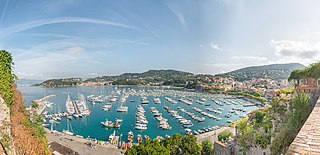
The Italian Riviera or Ligurian Riviera is the narrow coastal strip in Italy which lies between the Ligurian Sea and the mountain chain formed by the Maritime Alps and the Apennines. Longitudinally it extends from the border with France and the French Riviera near Ventimiglia eastwards to Capo Corvo which marks the eastern end of the Gulf of La Spezia and is close to the regional border between Liguria and Tuscany. The Italian Riviera thus includes nearly all of the coastline of Liguria. Historically the "Riviera" extended further to the west, through what is now French territory as far as Marseille.
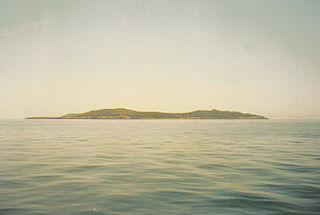
Giannutri is a small island in the Tyrrhenian Sea off the coast of Tuscany, Italy; it is the southernmost island of the Tuscan Archipelago and it is a frazione of the comune of Isola del Giglio in the Province of Grosseto.

Montecristo, also Monte Cristo and formerly Oglasa, is an island in the Tyrrhenian Sea and part of the Tuscan Archipelago. Administratively it belongs to the municipality of Portoferraio in the province of Livorno, Italy. The island has an area of 10.39 km2 (4.01 sq mi), is approximately 4.1 km (2.5 mi) wide at its widest point, and is 3.4 km (2.1 mi) long; the coasts are steep, and extend for 16 km (9.9 mi). The island is a state nature reserve and forms part of the Tuscan Archipelago National Park.

Ischia is a volcanic island in the Tyrrhenian Sea. It lies at the northern end of the Gulf of Naples, about 30 kilometres from the city of Naples. It is the largest of the Phlegrean Islands. Although inhabited since the Bronze Age, as a Greek emporium it was founded in the 8th or 9th century BCE, and known as Πιθηκοῦσαι, Pithekoūsai.

The volcanism of Italy is due chiefly to the presence, a short distance to the south, of the boundary between the Eurasian Plate and the African Plate. Italy is a volcanically active country, containing the only active volcanoes in mainland Europe. The lava erupted by Italy's volcanoes is thought to result from the subduction and melting of one plate below another.

Baiae was an ancient Roman town situated on the northwest shore of the Gulf of Naples and now in the comune of Bacoli. It was a fashionable resort for centuries in antiquity, particularly towards the end of the Roman Republic, when it was reckoned as superior to Capri, Pompeii, and Herculaneum by wealthy Romans, who built villas here from 100 BC. Ancient authors attest that many emperors built in Baia, almost in competition with their predecessors, and they and their courts often stayed there. It was notorious for its hedonistic offerings and the attendant rumours of corruption and scandal.
Formia is a city and comune in the province of Latina, on the Mediterranean coast of Lazio, Italy. It is located halfway between Rome and Naples, and lies on the Roman-era Appian Way.
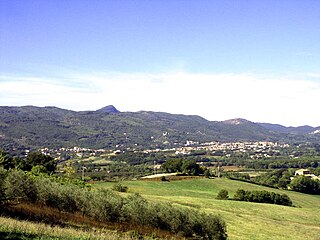
The province of Caserta is a province in the Campania region of Italy. Its capital is the city of Caserta, situated about 36 kilometres (22 mi) by road north of Naples. The province has an area of 2,651.35 square kilometres (1,023.69 sq mi), and had a total population of 924,414 in 2016. The Palace of Caserta is located near to the city, a former royal residence which was constructed for the Bourbon kings of Naples. It was the largest palace and one of the largest buildings erected in Europe during the 18th century. In 1997, the palace was designated a World Heritage Site.

The Tuscan Archipelago is a chain of islands between the Ligurian Sea and Tyrrhenian Sea, west of Tuscany, Italy.

Posillipo is an affluent residential quarter of Naples, southern Italy, located along the northern coast of the Gulf of Naples.

Parco Virgiliano is a scenic park located on the hill of Posillipo, Naples, Italy. The Park serves as a green oasis, built on the tufa stone typical to the coast of Posillipo.

Line 6 is a 5.5-kilometre (3.4 mi) light metro line that forms part of the Naples Metro. The four-station first part of the line opened in 2007, but was then closed from 2013 to 2024. It was reopened for service and extended to eight stations on 17 July 2024.
Line 10 is the name of the underground Naples Metro line being built designed to connect the Naples Afragola station of the Rome-Naples high-speed railway with the historic Centre of Naples, with interchanges with Line 1, Line 2, Line 11 and the Circumvesuviana railway. The line itself is designed to be automatically guided (driverless) and connect the municipalities of Afragola, Casavatore, Casoria and Naples, as well as a branch called "Baffo di Arzano" to connect the municipality of Arzano with two stations.

Dino is the larger of the two small islands in the Tyrrhenian Sea, off the coast of Calabria. The island is situated off Cape Arena, near to Praia a Mare. The name of the island either derives from Italian aedina, a temple, or Greek dino, a vortex or storm.

Licosa is a southern Italian village and hamlet of Castellabate, a municipality in the province of Salerno, Campania. As of 2009 its population was of 82.

The Metropolitan City of Naples is a metropolitan city in the Campania region of Italy. Its capital is the city of Naples. The province was established on 1 January 2015 and contains 92 comuni . It was first created by the reform of local authorities and established by Law 56/2014, thus replacing the province of Naples in 2015.
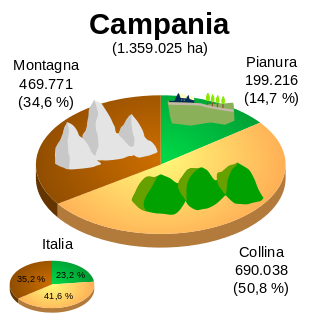
The geography of Campania illustrates the geographical characteristics of Campania, a region of Italy.
